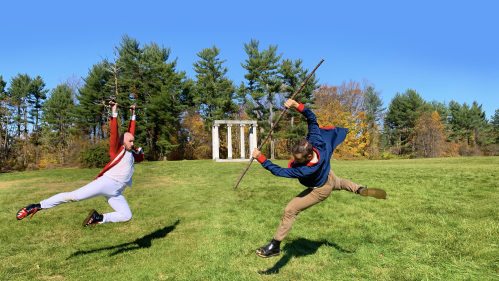Mason Gross Student’s 360-Degree Dance Video Project Brings Princeton Battlefield to Life

The Time Travelers’ Lens, an extended reality experience, knits together U.S. history and dance

Before starting on her MFA in dance at Rutgers University–New Brunswick’s Mason Gross School of the Arts, Merli V. Guerra had spent two decades focused on another passion: bringing history to life.
She worked early in her career as a historical interpreter for both Louisa May Alcott’s Orchard House and the Paul Revere House, both in Massachusetts. Over time, her focus evolved to combine her interests in historically based community engagement arts programming and dance.
She went on to co-found and direct the award-winning Boston-based Luminarium Dance Company and now also directs its Princeton, New Jersey, satellite company. In 2012, Guerra created an outreach project through Luminarium, producing annual public events that celebrate local cultural and historic landmarks through an integration of history and choreography.
It was a journey that led her to her current MFA thesis, which sheds light on an architectural curiosity, the Ionic Colonnade that marks the gravesite of fallen Revolutionary War soldiers at Princeton Battlefield State Park.
“I’m originally from Concord, Massachusetts and, as a result, I was steeped in Revolutionary War history. Concord is home to the Old North Bridge where the ‘shot heard round the world,’ the first shot of the Revolutionary War, rang out,” said Guerra, who now lives near Princeton. “I grew up thinking it was normal to see Minutemen (reenactors) walk down the street and, like any good Concord native, I owned a tricorn hat at the age of three.”
After her fiancé (now husband) moved to the Princeton area from Boston five years ago, he brought the Colonnade to her attention.
“He called to tell me that he had come across an architectural ruin that he knew would pique my interest as an artist and history lover,” said Guerra, who graduates in May.

For her master’s thesis, Guerra created five 360-degree, extended reality videos that use dance to tell stories surrounding the structure, which adorns the site of the 1777 Battle of Princeton, which helped turn the tide of the Revolutionary War. The Ionic Colonnade was built a half-century later – and in Philadelphia, not Princeton. It was part of a mansion designed by Thomas Ustick Walter, an architect of the U.S. Capitol Building. After the original mansion’s demolition in 1900, the structure of four stone columns was moved to Princeton, to adorn another mansion, Mercer Manor, which stood at the edge of the battlefield. The Colonnade survived the 1957 demolition of Mercer Manor and was dedicated as a National Historic Monument in 1962. It serves today as a marker for the nearby gravesite of fallen American and British Revolutionary War soldiers.
Guerra’s videos will be available for viewing on smartphones and other electronic devices via her website for The Time Traveler’s Lens beginning April 19, known as Patriots’ Day, which marks the beginning of the war for independence. Because they are 360-degree videos, the performances and their surroundings can be viewed from any angle.
“The pairing of my professional backgrounds in history and the arts allows me to contribute an historically insightful perspective to the site-specific dance field that goes deeper than the current identity of a site, asking: What purposes did this space serve? What joys did it witness? What tragedies? How might one engage the public with its stories?” Guerra said.
Guerra’s five videos for her thesis project include In Revolution, an acrobatic re-creation of the Battle of Princeton in which two dancers represent a British and an American soldier. In Passage, gray-clad dancers represent the marble columns as they make their trek up the Delaware and Raritan Canal from Pennsylvania to New Jersey. Dwelling shows a view into the lives of the three Philadelphia and Princeton families who knew the Colonnade as part of their homes. Conception: Architect as deity and Remains: Architect as mortal depict Walter, the Colonnade’s designer, at the structure’s creation and in the 21st century.
The five videos will remain available indefinitely after their Patriots’ Day launch, Guerra said. They will be accessible free of charge to visitors who follow the clues on Guerra’s website to a code word that can be found at the Princeton Battlefield site itself, she said. For those unable to visit the grounds in person, a one-time ticket fee unlocks the site, with all funds going directly towards Luminarium’s future community programming.
“I entered the Mason Gross School of the Arts’ MFA in Dance program with the goal of gaining a deeper connection to my New Jersey community, both in the dance scene and beyond,” Guerra said. “The opportunity for an in-person cohort with fellow dance artists was important to me, as I split my time between Boston and Princeton. COVID may have put that aspect of the program on hold, but this final project has prompted me to dig deep into local history. I now have a stronger connection to New Jersey’s roots and my community as a result.”
More information is available here.


